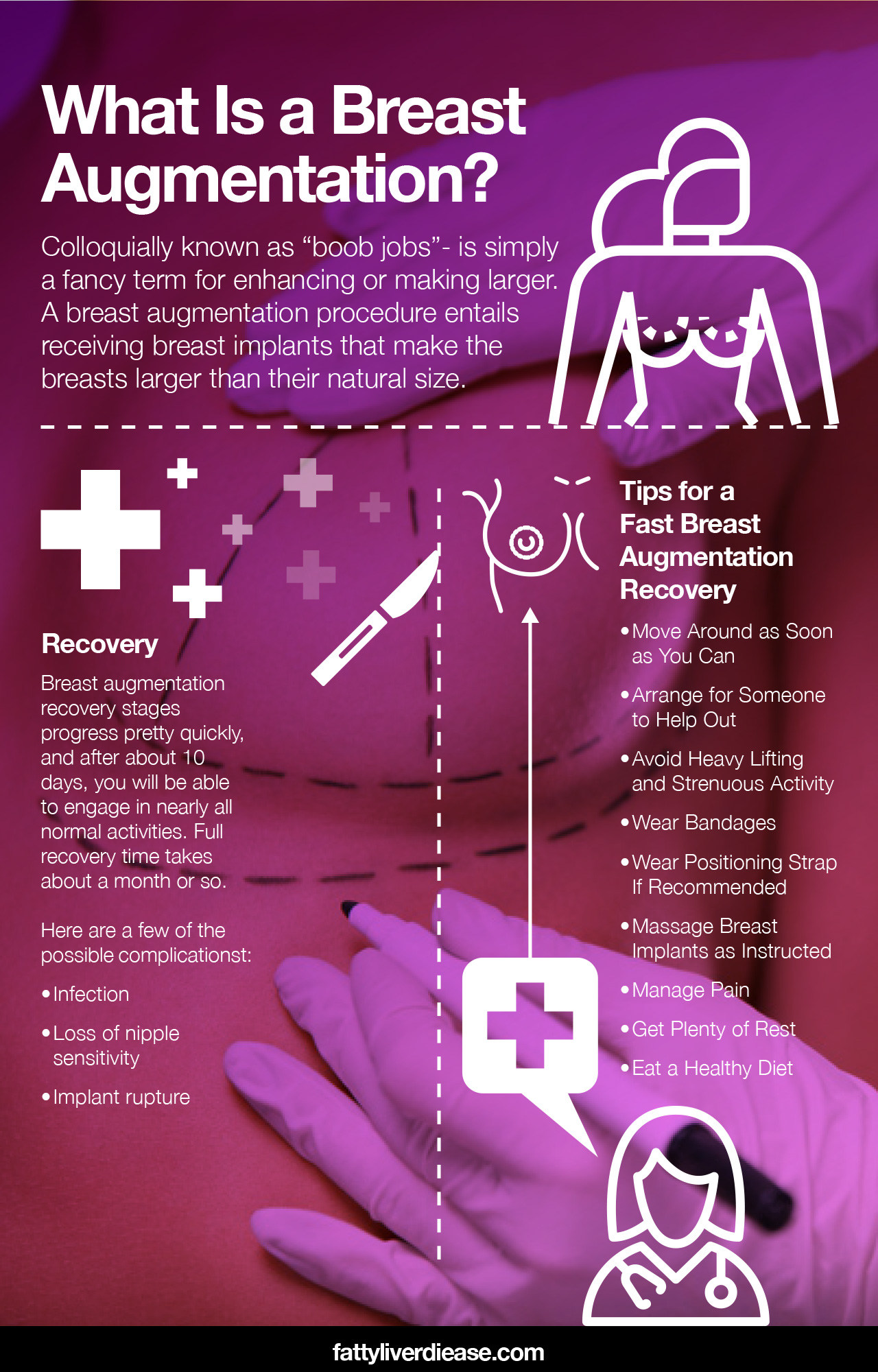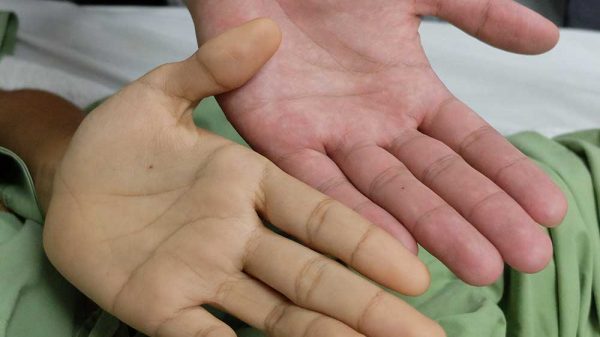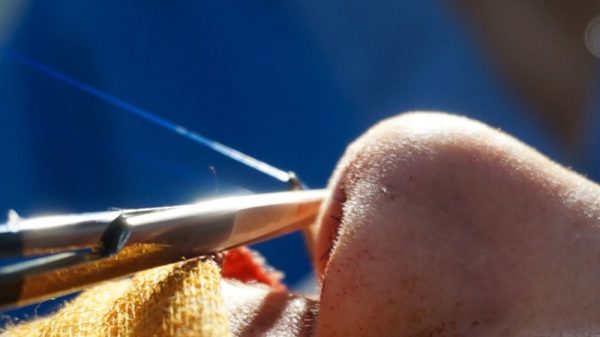If you are planning to get a breast augmentation or you’re considering getting one, it’s helpful to know what to expect throughout the surgery and the recovery process. In this article, we answer all of your questions about what to expect during the surgical procedure and breast augmentation recovery.
Keep reading to find out about how you can facilitate a fast and successful breast augmentation recovery.
What Is a Breast Augmentation?
Breast augmentations – colloquially known as “boob jobs”- are becoming more and more common in the United States. “Augmentation” is simply a fancy term for enhancing or making larger. A breast augmentation procedure entails receiving breast implants that make the breasts larger than their natural size.
Breast augmentation surgery is performed by plastic surgeons and is a form of cosmetic surgery. Though many women who have had a mastectomy elect to undergo breast augmentation surgery, under these circumstances the procedure is referred to as breast reconstruction. In this article, we focus primarily on breast augmentation surgery for cosmetic purposes. For more information about breast reconstruction surgery, check out this article on the DIEP flap procedure.
Why Might You Get a Breast Augmentation?
Many women elect to get breast augmentation surgery to enhance breast size and to feel more confident and comfortable. Especially after breast-feeding and at an older age, it’s common for natural breasts to sag and potentially shrink a little bit. Undergoing breast augmentation helps lift and revitalize your breasts.
Preparing for Your Breast Augmentation
As you’re preparing to undergo breast augmentation, you will consult with your board-certified plastic surgeon and attend pre-operative appointments. Your surgeon will guide you through the different options that you have for implant sizes and material, as well as the placement of the implant.
You will discuss with your surgeon the choice between saline and silicone implants. Saline implants are generally regarded as safer since they are simply saltwater. However, saline implants tend to feel a little less realistic, and if you have a low body fat percentage, sometimes the ripples of the implant material can be noticed through the skin. Silicone implants have a more realistic feel, though they are more dangerous if the implant were to rupture.
You will also discuss with your surgeon the best placement for your implant. For women who have not yet had children, your surgeon may suggest placing an implant beneath the chest muscle. Therefore, the implant is out of the way and doesn’t obstruct the breastfeeding process. For women past childbearing age, it may make sense to place an implant on top of the muscle.
Your surgeon will also discuss the size of the implant that works best for your needs. Plastic surgeons have a significant amount of training and experience and are able to provide invaluable guidance on what size implant would work best for your frame.
Surgery Day: What to Expect
On surgery day, you will first be prepped for the procedure in a separate room. We will meet with your anesthesiologist, who will provide helpful guidance and reassurance about the surgery. Your plastic surgeon will then come in and make sure that you were prepared for the surgery and understand the procedure. He or she will also use a marker to mark off certain incision areas.
You will then be wheeled back to the recovery room. At this point, nurses and surgical technicians will administer medications to help you drift off into a state of unconsciousness.
The details of the procedure will differ based on the kind of surgery you’ve chosen. If you are receiving implants that are placed under the muscle, your surgeon will make incisions below your breast, and insert the implants that way. If you are receiving implants that are placed above the muscle, the surgeon will likely make incisions around the nipple and insert the implants that way. Depending on your specific needs, the plastic surgeon may also perform a breast lift in conjunction with breast augmentation. The procedure itself will take up to two hours.
After the procedure, you will be wheeled to the recovery room where you will stay until the anesthesia wears off.
What to Expect Post-Surgery
Immediately following surgery, you will feel very groggy because you are still recovering from anesthesia. Throughout the first week following surgery, you will experience a significant amount of bruising, soreness, and swelling. After implants have been put in place, your skin must accommodate the newly placed objects by stretching, which causes a significant amount of pain. You will face difficulty lifting your arms and you may require assistance getting out of bed.
Recovery Time for Breast Augmentation
So, how long does a boob job take to heal? Breast augmentation recovery time takes about a month or so, if we’re talking about a full recovery of all tissues. However, recovery stages progress pretty quickly, and after about 10 days, you will be able to engage in nearly all normal activities.
Complications
As with any surgical procedure, complications are possible with a breast enhancement procedure. However, serious complications are rare. Cosmetic procedures like breast enhancements and breast reductions tend to be very safe when performed by a board-certified plastic surgeon.
Here are a few of the possible complications:
- Infection: As with all surgical procedures, cutting open any part of the body exposes tissues to the outside air and everything that comes with that – including bacteria. Infection can be prevented with proper wound care. If you notice redness, swelling, irritation, and oozing around the incision site or if you have a fever, seek medical attention right away. Getting on antibiotic treatment is crucial for clearing the infection.
- Loss of nipple sensitivity: This complication is rare, but causes very undesirable outcomes for women who still plan to have children. If a woman loses nipple sensitivity, she is unable to effectively breastfeed babies.
- Implant rupture: This is very rare, but can cause health consequences if the implants are made of silicone.
Tips for a Fast Breast Augmentation Recovery
Following surgery, you want to make sure you are prepared and manage the healing process as effectively as possible. You also want to help your body heal efficiently, so you can return to your normal activities as soon as possible.
1. Move Around as Soon as You Can
Moving around post-surgery is crucial for helping prevent blood clots, which are a serious side effect of any surgery. When you are on the operating table, you are lying stationary, which means your circulation decreases. This allows your blood to pool and increases the risk of forming clots. Soon after surgery, it’s important that you start walking around as soon as you are clear to do so. Walking around enhances blood circulation and decreases the risk of developing a blood clot.
2. Arrange for Someone to Help Out
In the first few days following surgery, it will be difficult to accomplish tasks on your own as you heal from your surgery. Have a trusted friend or family member drive you home after the surgery since you will be pretty groggy following general anesthesia. It’s also important to note that a breast augmentation surgery is an outpatient surgery, and you’ll be returning home the same day that you arrived at the hospital. The one exception is if you encounter any complications, which is rare. It may also be helpful for someone to help prepare meals and to help out around the house with small tasks and daily activities.
3. Avoid Heavy Lifting and Strenuous Activity
For several weeks following your breast augmentation, you want to make sure that you avoid lifting anything heavy. Lifting heavy objects, engaging in strength training of the upper body, or doing intense physical activity too soon after surgery can increase your risk of injury and bleeding. It’s a good idea to wait about a month before lifting heavy things and engaging in strenuous activity.
4. Wear Bandages
It’s important to follow all postoperative care instructions to make sure that your new breasts heal as well as possible. You will likely be instructed to wear bandages on the incision sites. It’s important to take care of the incision sites, replace bandages as needed, and to keep them clean to avoid infection.
5. Wear Positioning Strap If Recommended
Following your breast augmentation surgery, it’s likely that your plastic surgeon is recommended that you wear a thick strap that wraps around your back and sits above your new breasts. The point of this thick strap is to ensure that as your breasts heal, they remain in a position on your chest that looks natural. Without the positioning strap, new breasts have a tendency to sit a little further up on the chest.
6. Massage Breast Implants as Instructed
Massaging your new breast implants is crucial for the healing process. Your surgeon will instruct you on how and when to begin massaging your breast implants. Many times, you will need to begin massaging about a week following the surgical procedure. So, why is it necessary to massage your breast implants? After surgery, the body needs to heal from trauma. Scar tissue develops naturally, and massaging helps prevent the implants from being stuck in place.
What happens if you don’t massage your breast implants? Not massaging your implants leads to the formation of hardened scar tissues in breast tissues around the implant. This scar tissue has a tendency to essentially lock the implants in place, which may not look natural. Instead, you want your new breasts to be mobile with natural placement.
There is one caveat – massaging your breast implants can be extremely painful since post-operation you will feel very sore. To ease the pain a little bit, try massaging the implants when you shower since the warm water can be soothing.
7. Manage Pain
Managing pain is an important part of postoperative care. As mentioned above, you will be experiencing a great deal of soreness and bruising following surgery. Your surgeon will likely prescribe you a strong prescription pain medication that you can take for the first few days or so following surgery. Your surgeon will instruct you on how long to take this pain medication.
8. Get Plenty of Rest
Getting plenty of sleep and taking it easy after breast augmentation surgery is important to facilitate the healing process. So much healing happens while we are asleep and the immune system works hard to direct nutrients and energy towards the healing wound. If you push yourself too hard following surgery, the body will be unable to heal as efficiently.
9. Eat a Healthy Diet
Last but not least, it’s important to eat foods that support the recovery process. Here are a few of the foods that you should be eating as you recover:
- Fiber: Dietary fiber is essential for lowering inflammation throughout the body. When we consume insoluble dietary fiber from fruits and vegetables, much of the fiber travels through the digestive tract intact. In the intestines, it feeds good bacteria, which produce anti-inflammatory byproducts that travel throughout the body. Fiber also helps fight against constipation that is common after any surgery that requires pain medication. Opioid-based pain medications cause constipation that can be relieved by eating plenty of fruits, veggies, whole grains, and beans.
- Micronutrients: Micronutrients are a vital part of the post-surgery diet. Micronutrients encompass a variety of small compounds that the body needs to function efficiently. Vitamins, minerals, and antioxidants are all micronutrients and they all help the body heal after surgery. Nutrients such as vitamin C, zinc, polyphenols, and carotenoids are all helpful in supporting the immune system to rebuild damaged tissue from the surgery. To get the micronutrients you need to support your immune system, it’s important to eat a variety of fruits, vegetables, beans, nuts, seeds, and whole grains.
- Protein: Eating high-quality protein is important for supporting breast augmentation surgery recovery. Protein affords essential amino acids, which are the small nitrogenous compounds that the body requires to synthesize and repair muscle tissue, skin, and collagen. You can get balanced ratios of essential amino acids from any single animal-based protein, such as meat, eggs, dairy, and fish. If you follow a vegetarian diet, you can get optimal ratios of essential amino acids by combining a variety of vegetable-based protein throughout the day. For example, aim to eat whole grains, beans, and nuts on a daily basis.
Breast Augmentation Recovery: Conclusion
Breast augmentation surgery is a form of plastic surgery that enhances the size of your breasts. Achieving a smooth recovery from a breast enhancement requires pain management, massaging the implants, getting lots of rest, and eating healthy foods. Following all of these steps during recovery is vital to ensuring that you make a full recovery and that you are pleased with the final results.
























